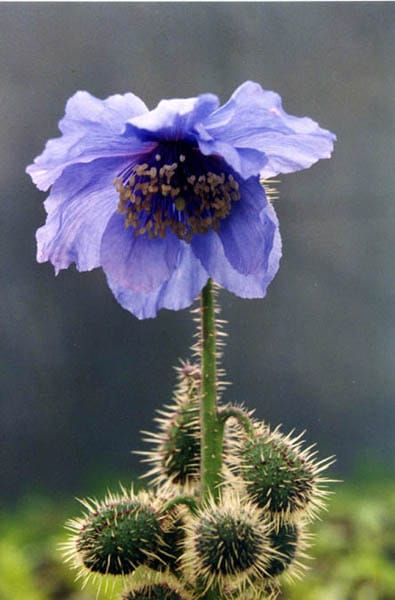Meconopsis horridula, Tsher sngon ཚེར་སྔོན
Prickly blue poppy, Spiny meconopsisTsher sngon (Tibetan)
Duo ci lu rong hao (TCM)
Gul-e-Nilam (Unani)
Kanderi (Ayurveda)
 Meconopsis horridula
Meconopsis horridulaPhoto by Ghislain118) (Wikimedia)
Botanical name:
There are 2 sources for this Medicine:
- Meconopsis horridula (syn. M. horridula var. rudis, M. pratti, M. racemosa, M. rudis, M. sinuata var. pratti)
- M. aculeata
Parts used:
Whole plant, Root
Temperature & Taste:
Cool, dry. Bitter
Uses:
1. Moves the Blood, Strengthens Bones, Relieves Pain: (Tibet, TCM)
-Bruising, Trauma, Fractures
-Heat in the Bones
-strengthens Bones
-Head Wounds, especially Head fractures
-Pain in the Ribs, Chest, Back or Upper body
-pain and swelling of the joints
-Tumors, Cancer
2. Clears Heat, Settles Wind:
-clears Heat from the Blood (whole plant)
-pricking pains in the upper body
-Wind-Heat Headache, Hypertension
-Heart disorders
3. Externally:
-paste is applied for Rheumatic pain
Dose:
Substitute:
Flowers of Echinops latifolius have been used as a substitute by Tibetans in Russia.
Main Combinations:
1. Wind-Heat affecting the Blood, pain in the Upper Back, Hypertension, Tinnitus, Vertigo, Meconopsis horridula with prepared Nux Vomica, Inula racemosa, Tinospora, Chebula, Aloeswood, Nutmeg (as in Nux Vomica 13 of Tibetan Medicine)
2. Fractures, Trauma, Meconopsis horridula with Shilajit, Madder
Major Formulas:
Nux Vomica 13 (Ko byi bcu gsum) (Tibetan)
Aloeswood 17 (A gar bcu bdun) (Tibetan)
Aloeswood 35 (A gar 35) (Tibetan)
Red Pony (Rta zi dmar po) (Tibetan)
Turquoise 25 (Rin Chen byu rnying nyer lnga) (Tibetan)
Cautions:
None noted
Main Preparations used:
Research
1. [Chemical constituents from a Tibetan medicine Meconopsis horridula].2. [Advance of a representative traditional Tibetan medicine Meconopsis horridula on its phytochemical and pharmacological aspects].
3. Chemical constituents of Meconopsis horridula and their simultaneous quantification by high-performance liquid chromatography coupled with tandem mass spectrometry.
4. The antitumor activity of Meconopsis horridula Hook, a traditional Tibetan medical plant, in murine leukemia L1210 cells.
